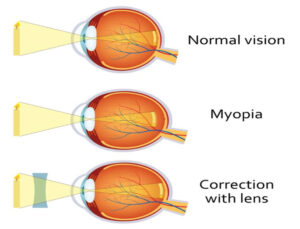Myopia Management
 What is Myopia?
What is Myopia?
Myopia is often referred to as nearsightedness—a refractive error in the eye. The error occurs when light is no longer bent or refracted correctly by the eye, and as a result, images become blurry when at a distance. Close-up focusing remains normal.
Myopia occurs when the eye grows longer than normal, or the cornea is too steep. As a result, light rays focus in front of the retina, versus on the retina, causing the distance to be out of focus or blurry.
Depending on the magnitude of the refractive error, and the amount of correction needed, Myopia can be categorized as mild, moderate, or severe. Typically, a prescription can be considered mild at as little as -1.00 diopters, and any prescription greater than -5.00 diopters can be considered severe.
Causes
On average, Myopia is first detected in children between the ages of 6 to 12 years old and evidence suggests that there is a genetic, or hereditary, component to the condition. According to studies, there is a 25% chance that a child will develop myopia if one of their parents is myopic. The statistic increases to a 50% chance if both parents are myopic.
Studies suggest that environmental conditions can enhance or accelerate nearsightedness. Many have attributed excessive screen time on small digital devices as contributors to a child’s condition. Per a recent Taiwanese study, sunlight, spending time outdoors, and sporting activities were found to be ways of reducing or slowing the onset.
Symptoms
Some of the signs and symptoms of Myopia are:
- Eyestrain or headaches
- Squinting to see properly, sitting in the front row during class, or excessive blinking
- A decline in educational performance or complaints that your child cannot see the whiteboard
Parental vigilance is critical; signs that your child is becoming unengaged, or is struggling in school, could identify a potential vision problem, such as Myopia.
Risks
Later in life, and if nearsightedness progresses, there are linkages to an increased risk for retinal detachment, glaucoma, cataracts, and myopic maculopathy—an irreversible loss of central vision.
Treatment
Prescription eye drops or contact lenses are the most common methods for addressing symptoms of Myopia. Both methods work by refocusing light rays on the retina, to compensate for the shape of your eye. Specialty contact lenses have been developed to address myopic conditions; therefore, wearing eyeglasses and/or contact lenses full-time may not be necessary. Our doctor will advise you on the best treatment option for your health.
Atropine Eye Drops
Atropine Eye Drops are specially formulated, low dose eye drops that must be compounded through a specialty pharmacy. The drops are instilled into the eyes each night, slightly dilate the pupil, and cause the eyes’ focusing mechanisms to relax. This in turn, significantly reduces myopia progression in children. One of the side effects of this medication is light sensitivity; therefore, transition or photochromic glasses, and sunglasses, are strongly recommended.
How do they work? What is the cost? Atropine Eye Drops, and the associated Myopia Management, cost $990—the price includes a year supply of the drops and quarterly follow-ups with the doctor. The patient is seen every 3 months so that the doctor can monitor the effectiveness of the medication; in some instances, the doctor will need to raise the concentration of the medication or adapt treatment. The price is recurring each year, as the patient will need to continue treatment throughout childhood. After each quarterly visit, the medication will be ordered and shipped to the office; drops can either be picked up from the office, or shipped to your house, for an additional $14.95 shipping fee.
Hard Specialty Night Contact Lenses/Ortho-K Contact Lenses
Orthokeratology is becoming an increasingly popular method for treating Myopia. Our office has been fitting Specialty Ortho-K Contact Lenses since 2005. Ortho-K uses a series of gas permeable contact lenses to slowly reshape and gently flatten the cornea, while reducing Myopia as your child sleeps. The lenses are worn only at night and the eye will retain the new shape for 20 hours. The vision improvement is temporary; after you stop using the lenses, your cornea reverts to its original shape and the myopia returns.
Many refer to the treatment as Corneal Reshaping, which works in a similar way for the eyes, as dental braces work for the teeth. These “eye retainers” are worn at night, removed in the morning, and vision is perfectly corrected all day; the need for daytime eyeglasses, soft contact lenes, or ocular surgery is replaced.
How do they work? What is the cost? These specialty contact lenses require a series of visits, and numerous images of the surface of the eye, to fit these specialty lenses. Within the first 3 months, several follow-up visits will be scheduled so that the doctor can get the fit and prescription of the lenses exact. The cost for the first year of treatment is higher, but the cost tapers down during subsequent years. Fees range between $2000 – $2600 for the first year, and $900 – $1200 for the following years. The fee for treatment depends on the complexity of your eyes, as well as the prescription, and includes all follow-up visits and a new pair of lenses for the year.
Soft Daytime Contact Lenses
Some Soft Multifocal Contact Lenses are specially designed to be shaped like a bullseye. Such contacts have two distinct portions for focusing light: the center portion of the lens corrects nearsightedness, by focusing light directly on the retina so that distance vision is clear, and the outer portion of the lens brings the peripheral light rays into focus, in front of the retina, by adding focusing power. Medical studies have shown that focusing light in front of the retina, cues the eye to slow development.
How do they work? What is the cost? Soft Multifocal Contact Lenses work similarly to Standard Soft Contact Lenses, that you may already be wearing. The lenses cost $1100 – $1500 each year; the fee for treatment depends on the complexity of your eyes, as well as the prescription, and includes all follow-up visits and a supply of lenses for the year.
For more information please schedule an appointment with your eye care provider, and we will be in touch with you shortly.
